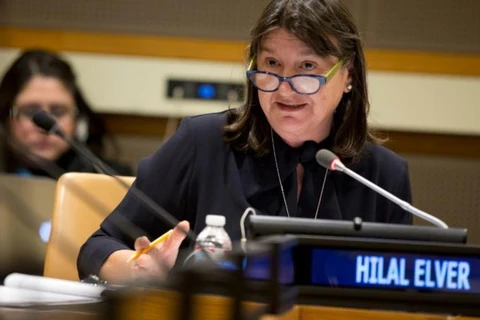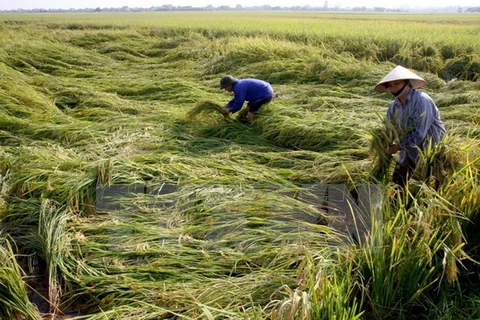Hanoi (VNA) - Vietnam is taking urgent action to ensure food security against the negative effects of climate change, which has resulted in heat waves, forest fires, floods and sea level rise in recent years.
Sunlight, temperature and rainfall are the main drivers of crop cultivation, hence, agriculture is directly affected by climate change. Many of these impacts are already measurable.
Vietnam is still considered an agricultural country, with approximately 70 percent of the population living in rural areas. The Mekong Delta is the largest agricultural production area in Vietnam, contributing 54 percent of the country’s rice output, 70 percent of aquatic production and 36.5 percent of fruit output. Up to 90 percent of rice exports and 65 percent of seafood shipments of Vietnam come from the Mekong Delta, according to Dao Anh Dung, Vice Chairman of the Can Tho city People’s Committee.
However, the Mekong Delta is among the areas hardest-hit by climate change and sea level rise. Last year, record extreme weather affected 13 provinces in the region, causing water shortages for millions of people and losses of some 800,000 tonnes of rice.
According to Deputy Minister of Agriculture and Rural development (MARD) Le Quoc Doanh, up to 32.2 percent of agricultural areas will be affected by climate change by the end of the 21st century.
Production of major crops like rice and corn are projected to reduce dramatically if global average temperature increases by two degrees Celsius. Climate change has also left far-reaching impacts on livestock production and aquaculture.
Stepping up climate-friendly agricultural production
Agriculture is directly affected by climate change. But agriculture also affects the climate as it is responsible for about one-third of greenhouse gas emissions, a major cause of global warming. About 25 percent of carbon dioxide emissions are produced by human practices, mainly deforestation and use of fossil fuel-based fertilisers. Most of the methane in the atmosphere also comes from agricultural activities, such as livestock breeding, rice cultivation, and burning of plant materials.
To ensure food security, the agriculture sector has made efforts to minimise risks from floods, droughts and rising temperatures, and at the same time, reduced its contribution to climate change, giving an impetus to climate-friendly agriculture.
According to Doanh, Vietnam has focused on applying scientific and technological advances in agricultural production. Many climate-friendly agriculture models have been developed, which reduce the use of fertilisers, chemicals, water and gas emissions by 30 percent while increasing rice productivity by 10-20 percent.
To adapt to climate change, the agriculture sector has restructured itself in order to increase farm productivity and quality by using suitable plant, livestock and fish varieties, forming value chains and drawing investment into the sector while minimising climate change impacts by practicing smart cultivation.
Vietnam has launched an action plan for climate change adaptation and mitigation in the agriculture and rural development sector for the 2016-2020 period, with a vision through 2050. The country has also committed to mobilising all resources to implement the Agenda 2030 for Sustainable Development and the Paris Agreement on Climate Change.
Vietnam has also sought stronger regional cooperation in the work. One of the four priorities Vietnam proposed for the APEC Vietnam 2017 is to “Enhance food security and sustainable agriculture in response to climate change.”
Bright prospects for Vietnam’s rice exports
Climate change is threatening the world’s ability to ensure food security, eradicate poverty and achieve sustainable development. The United Nations has recently projected that up to a quarter of the global food production could be lost by 2050 due to the combined impacts of climate change, land degradation and water scarcity. At the same time, the world’s population is expected to increase to about 9.5 billion. The United Nations Food and Agriculture Organisation (FAO) said that an increasing population will drive demand for food up by to 60 percent by 2050, making food security a key issue of the whole world.
 Harvesting rice in Vi Thanh commune, Vi Thanh district of the Mekong Delta province of Hau Giang.jpg Bỏ file này
Harvesting rice in Vi Thanh commune, Vi Thanh district of the Mekong Delta province of Hau Giang.jpg Bỏ file này According to MARD, there are significant potentials for Vietnam to expand rice exports. The agriculture sector has also taken measures to boost rice exports, including launching a strategy to develop the country’s rice export markets and ensure sustainable development in the production and export of rice.
One of the strategy’s goals is to maintain a total rice growing area of about 3.8 million hectares in 2020, with total rice output of 41-43 million tonnes. Vietnam’s annual rice export volume is expected to reach about 4.5-5 million tonnes by 2020, earning an average of about 2.2-2.3 billion USD per year. From 2021 to 2030, the nation’s annual rice export volume is expected to hit about 4 million tonnes, raking in 2.3 to 2.5 billion USD per year. It also hopes to increase the value of exported rice.-VNA
One of the strategy’s goals is to maintain a total rice growing area of about 3.8 million hectares in 2020, with total rice output of 41-43 million tonnes. Vietnam’s annual rice export volume is expected to reach about 4.5-5 million tonnes by 2020, earning an average of about 2.2-2.3 billion USD per year. From 2021 to 2030, the nation’s annual rice export volume is expected to hit about 4 million tonnes, raking in 2.3 to 2.5 billion USD per year. It also hopes to increase the value of exported rice.-VNA
VNA























